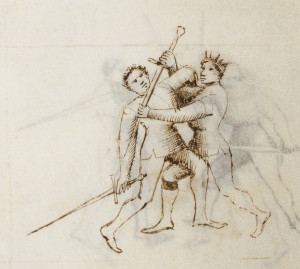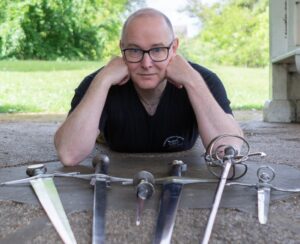Table of Contents
ToggleTo Share or Not To Share?
A good martial artist is responsive, not reactive. This is one of the key life benefits from martial arts training, so I’ll explain in some detail.
Recently, some anonymous fool posted a long and completely valueless article dissing HEMA on the grounds that it is not optimised for street self-defence or MMA. It was an obvious example of a straw-man argument, criticising HEMA for something it has never pretended to be. Useful criticism is essential for growth (which is why I sent out 100 copies of the first draft of my book, The Theory and Practice of Historical European Martial Arts, for beta-readers to critique— and sure enough I had a month of revisions, corrections, and improvements to make). But this particular article was not offering constructive criticism, because the (very angry) writer was not criticising any version of HEMA I have ever come across.
The only reason I came across this waste of pixels and my time was because several of my colleagues shared it. They were furious, and so shared the article so everyone else could be furious too. This was reactivity, and such inappropriate behaviour on their part that I was simply appalled that supposedly trained martial artists would behave this way. Somebody was wrong on the internet, and their reaction was completely out of proportion, and very counter-productive. I thought about it for a while, then posted this on my Facebook wall (this was in 2017, when I was still active on social media):
“To my HEMA friends: some numbnut has written a long and eminently stupid article about how crap HEMA is. You know it's stupid, I know it's stupid. He probably knows it's stupid, which is why he's anonymous. So why the hell are you all sharing it? Attention feeds trolls. Traffic is king. Starve the troll, deny him traffic, and he will wither and die.
C'mon people, share the GOOD stuff, not the crap!
Anyone sharing the article in the comments will be blocked.”
And sure enough, a lot of people started thinking about whether they should share bad articles.
Can you see the difference? A reaction is immediate, and may or may not serve your interests. A response is deliberate, based on your skills and experience, and should, all things considered, serve your interests. In this case, my response was to call out the behaviour of colleagues who should know better, in the hopes that they would stop sharing low-quality material. It seems to have worked, and at least got some of them to think about what they were doing.
Please note that I don't give two hoots about the article itself: my response, of which this blog post is an expansion, is to the reactivity shown by my colleagues. I have some hope of influencing them with reasonable argument. That writer? Clearly not.
Responsiveness v. Reactiveness re productivity
It is generally good advice to avoid checking emails until after you’ve got something useful done in your working day. Your inbox is everyone else’s agenda; a to-do list that anyone with your email address can add to. Putting that first will tend to make you reactive, not responsive. Put your own agenda first, and you can then respond to other people’s afterwards, secure in the knowledge that whatever they want from you is not going to derail your day. It is a good idea to do whatever is necessary to avoid slipping into a reactive state of mind. Probably the best book on this at the moment is Cal Newport's Deep Work.
Three rules for remaining responsive on the internet
Absolutely nothing on the internet is so urgent that you can’t wait, breathe, think, and decide calmly what response, if any, is needed. In most cases, there is no action required. Bad blog posts have nothing in common with a sudden violent assault, or with something going wrong during heart surgery, or a van swerving into your lane on the highway, or any other time-critical thing. It’s the internet. It is never time-critical. There is always time to calm down and think rationally about how to respond.
I simplify my decision regarding sharing and commenting with three simple rules:
1) Only share if you're doing your friends a favour. If you admire it, like it, find it interesting, useful or engaging, then share away. If you don’t see positive value in it, don’t share it. That doesn’t mean I don’t share things I don’t agree with— I can disagree with a writer and still find their work useful, and thus shareable. If I come across an article that I feel should be responded to, but I don't want it to pass unchallenged, I'll share a link to it within the text of my response. You can see that in action in this wild rant. I had to respond, but I didn't just share the article. I should perhaps remind you that this post is not a response to the crappy article that was posted; it's a response to the behaviour of my colleagues in sharing something they knew was of no value.
2) If in doubt, do nothing. The back button is your friend. Nobody will notice that you did nothing.
3) If you feel it in your chest or gut, wait a day, better two or three. Strong emotion makes for bad decisions. In the example above, my colleagues were angry, frustrated, outraged. This lead them into profoundly counterproductive reactivity. It’s done the same for me many times.
I’m sure you can think of many exceptions; a friend’s mother dies, you feel it strongly, but you condole immediately, breaking rule three. These rules don’t apply in all situations. But I think if more people followed them most of the time, the internet would be a happier, safer, better, and more useful place.
Reactivity, the OODA loop, and operant conditioning
Reactivity has its place, of course. If you are suddenly attacked, you must react. There is a time-critical element, and anything you can do to shorten the time between stimulus and response is good. The primary training tool for this is called operant conditioning, and it works by breaking the OODA loop. When something happens, you Observe it, Orient to it, Decide on your response, and then Act. This is why surprise attacks work: you notice it, but while you are trying to rearrange your worldview to accommodate the idea that somebody is trying to hurt you, and deciding what to do about it, they hit you. Operant conditioning sets up the stimulus, and rewards you for acting immediately. No orientation, no decision. OODA becomes OA. This is also why it’s a very bad idea to sneak up on some people; if you surprise them, their reaction (e.g. Draw and shoot) may be completely out of proportion to the stimulus (e.g. Jump out and say boo!). In self-defence training, breaking the OODA loop through operant conditioning is the most important kind of physical training, though training situational awareness (so you can avoid the situation before it arises) should be the primary goal of any self-defence class. Regular readers of this blog know I'm a fan of Rory Miller; he's written a lot of useful stuff on this. Start with Meditations on Violence.
Responsiveness beats reactivity
The key to useful operant conditioning is establishing what constitutes an appropriate stimulus. Kid with water-pistol, don’t shoot. Operant conditioning is dangerous because it is really, really effective, and once learned is hard to train out of. It is not so useful for training for prearranged combat, such as duelling, fencing, sparring etc, because success in those arenas come from controlling the environment and seeing what your opponent will do in advance. A reactive opponent is easy to beat, because they will fall for feints very easily. Instead, we must train for responsiveness, which is quite different. A responsive person identifies the threat and can deal with it without having to short-circuit their reasoning skills. I have seen experienced police officers dealing with what to me would have seemed an incredibly dangerous environment, serious OODA loop territory, but for them it did not trigger a violent response. They remained responsive, not reactive, and brought the situation to a safe and gentle conclusion. It was a demonstration of very high-level martial arts.
If you find this article helpful, useful, interesting, or valuable in any way, please share it. If you think it’s rubbish, then let it die the internet death of no traffic. Don't inflict it on your friends!










